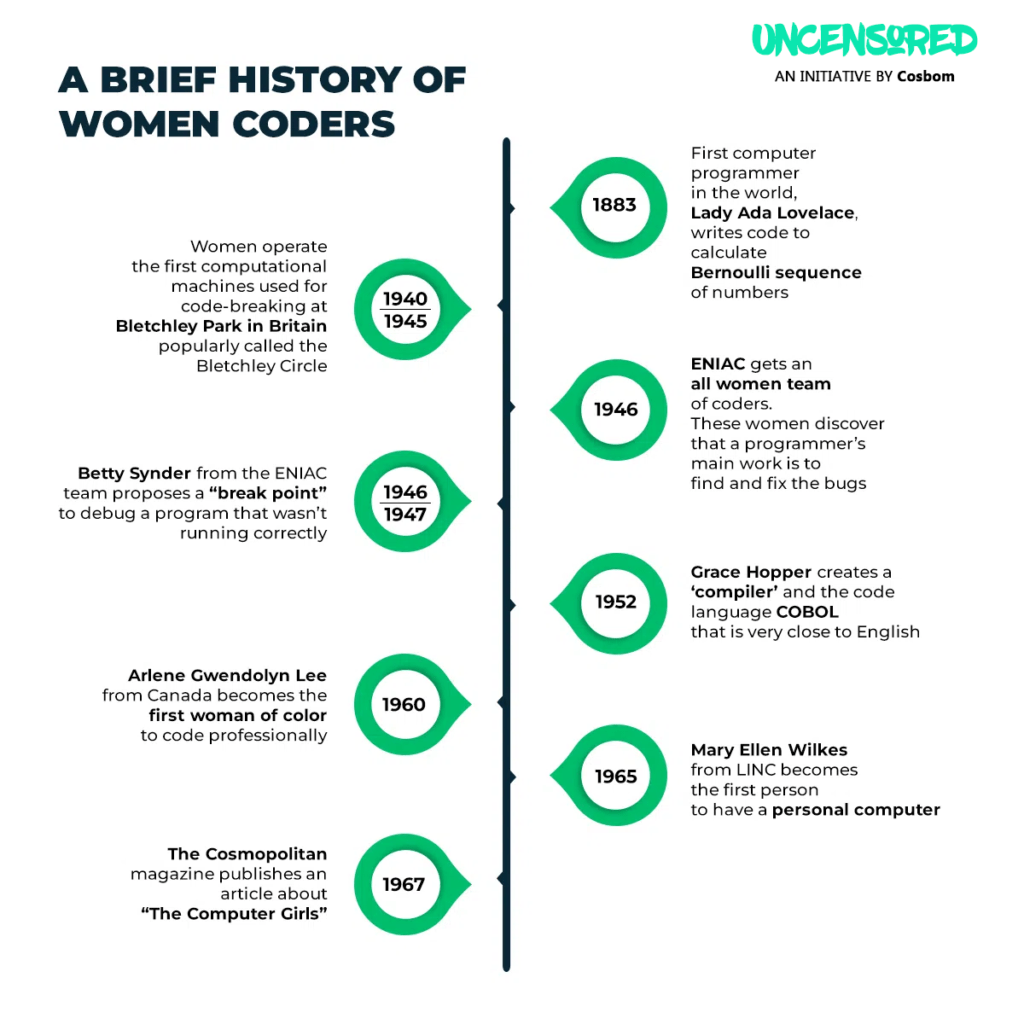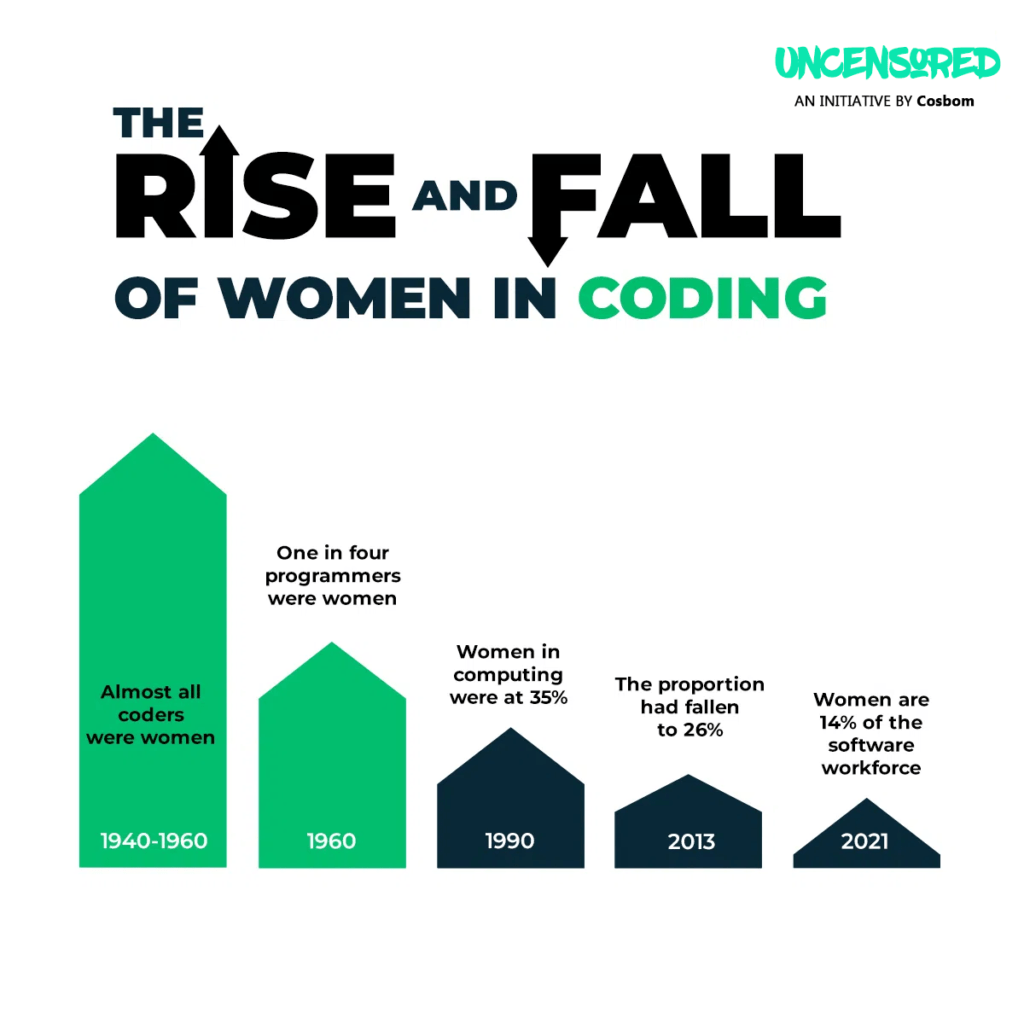Uncensored
Female Programmers Are On The Rise
Acquiring a new skill such as coding can be instrumental in enabling individuals to provide for their basic needs. In numerous instances, it can determine one’s ability to financially support their children’s education. Diane Kris brought to our notice the significance of women in coding through a tweet. For those unfamiliar, Kris, a software engineer at Tumblr, was a member of the inaugural cohort at Girls Who Code—an organization dedicated to reducing the gender disparity in technology occupations by empowering girls aged 13 to 17. Kris shared on Twitter:
Coding is frequently seen as a miraculous solution capable of resolving various challenges. Lately, there has been a significant emphasis on introducing more women to coding roles to address a persistently widening gender gap. However, a disconcerting statistic has emerged—only 14% of software engineers in the workforce are women. This isn’t merely a gender gap; it’s more accurately described as a gender ‘chasm.’ To understand whether this skewed gender ratio in technology has always existed or if it distorted over time, particularly since the advent of the first computers disrupting the landscape, we delved into the origins.

The prevalent, and somewhat stereotypical, image of the unkempt and reclusive male coder wasn’t always the standard. In the 1940s, coding was perceived as a task demanding precision and meticulous repetition—resembling activities such as knitting or diligently following a complex recipe, tasks often associated with women. Notably, women possessed an inventive spirit, exemplified by Lady Ada Lovelace, who authored the world’s first code. She crafted a code for calculating the Bernoulli sequence of numbers for Charles Babbage’s proposed Analytical Engine. Despite the machine never materializing, Lady Ada’s code stands as a groundbreaking achievement.
During World War II, women took the lead in codebreaking, utilizing large computer-like number-crunching machines. Their remarkable contributions to the war effort are vividly portrayed in films like “The Imitation Game” and “The Bletchley Circle.” Post-war, computers transitioned from being classified military secrets to disruptive scientific inventions. As computers were still in their infancy, both laboratories and companies sought individuals with the right aptitude, opening doors for numerous talented and renowned women coders in the 1950s and 1960s.

Examining the roster of renowned female coders and the timeline outlined above naturally prompts the question of what transpired with women in coding during the 1990s. In an article by The New York Times titled “A Secret History of Women in Coding,” several significant factors contributing to the decline in the representation of women in coding are elucidated.
- Changing Perceptions About Coding
Coding, despite great demand, was considered a menial or rather secretarial job till the ‘70s. But, as soon as coding started being perceived as cerebral, men, not women, were considered better suited to it. Looks like society pulled a Rosie the Riveter on women coders! - Lack of Equal Opportunities
In the ‘80s, most American homes started having personal computers (PCs). These PCs were most often installed in rooms of boys, not girls. Like baseball, computers became a source of male bonding among fathers and sons or friends. So, when boys came to coding courses in college, they were already way ahead of their female counterparts. - Inclusion of Entrance Tests
In the ‘50s and ‘60s, both men and women who trained in coding had never seen a computer before. So, women students got admission into courses on the basis of nothing more than an aptitude test. By the ‘80s, the demand for coding courses had snowballed and the universities had to add testing criteria for selection which ruled out many women students who had no prior experience with coding. - Cultural Hegemony
The vibe in campuses and in the job market was that you needed to code obsessively to be a good coder. This is when the prototype of a reclusive and nerdy coder with screen tan became itched in our collective consciousness. While this persona fitted men very well, it wasn’t acceptable for women to exhibit these characteristics.
The result? Fewer women applied to professional coding courses; even fewer graduated due to drop offs. And finally, the small number that made it to the job market did not end up getting a fair share there as well.
Although, The number of women in specialist IT roles in India is significantly higher than in the UK, a research by Open University has found.
In collaboration with the Indian IT trade association firm Nasscom, the study focused on IT professionals and middle management in companies in both the UK and India. The findings indicate that 35% of individuals holding specialized technology roles in India are women, in contrast to the 17% observed in the UK.
How can more women learn coding?
History may not have always dealt women a fair playing hand when it comes to coding professionally. But technology has leveled the playing field to a great extent. The constructive efforts by many organizations are also adding momentum to attempts at correcting this gender imbalance.
The following are some of the commendable highlights in the journey to having gender parity in coding jobs:
- Toolkits
Coding is a skill like any other and it cannot be completed without basic tools. Aspiring coders must learn to code. So, Girls Who Code catch them early between 13-17 years of age. They can enroll into various boot-camps and online courses on various platforms. - Peer-to-peer Learning
The TinkerHub Foundation, based out of Kerala in India, has introduced an interesting concept of peer-to-peer learning that can help students on campuses learn new technologies from peers by picking up a problem-solving approach. The CEO of TinkerHub, Mehar Mossa tells us, “In India, we study to get a degree and then a job. But that cannot be the end of learning when technology is growing so fast. That culture needs to change.”
Mossa started the Women in Technology wing of TinkerHub encouraged by the response he got from women on campuses. “We have the highest engagement from women participants for any tech events”, he explains.
Success Stories
Apart from the efforts mentioned above, success stories of other women coders can be a very strong impetus for more women to learn coding. So, we caught up with women from diverse backgrounds who have mastered the art of coding to know more about their inspiring journeys.
Coding for Working Moms
Emily Lubkert from North Carolina also comes from a teaching background and was looking to switch her career path. With two kids, she needed a job that had slightly more flexible timings than a school. She took the Professional Certificate in Coding: Full Stack Development with MERN from MIT xPRO without too much experience in coding. “I had a computer paper in college. But I never pursued it professionally so I assumed that door was shut,” she says. However, six months, a course, and some networking later, she is on her way to a new career! “I have been told that this is a good time to be a woman coder as a lot of companies are trying to correct the gender imbalance’, she says.
Leading by Example
Ananya R, a 24-year-old coder who works as a Community Manager at Google Developer Relations, told us that India has a unique problem. “Enough number of women study technology in India. But, they don’t pursue it as aggressively as men. Women usually leave tech careers after they get married or start a family,” she explains. Ananya, for the last one year, is trying to address this gender imbalance in her own way by working with Women in Technology, the women’s wing of TinkerHub. She conducts workshops in campuses and motivates more female students to take up coding seriously. “We have to put a face to women in coding. Only then can the girls relate,” she sums up, rather aptly.
Catch you in the next edition of

Uncensored
Women in Tech – Breaking the Silence and Shattering the Stereotypes
In a world where Silicon Valley’s glossy image often hides its dark underbelly, women in tech continue to fight battles that many in the industry would rather keep under wraps. The narratives of exclusion, sexism, and underrepresentation persist—even as extraordinary women build empires, break barriers, and redefine what it means to be a leader in technology. This column is for those who are done with the sanitized stories and are ready to confront the raw, unfiltered truth.
The Harsh Reality: A Boys’ Club That Still Rules
Despite the well-publicized success stories, the tech industry remains dominated by a “boys’ club” culture that devalues the contributions of women and nonbinary individuals. Recent research shows that women hold only 15% of C-suite roles in NASDAQ-100 tech companies, with even shorter tenures compared to their male counterparts, who average more than four years in leadership positions. This isn’t just a number—it’s a stark reminder of the systemic barriers that continue to push women out of decision-making roles and force them into burnout and attrition.
Stories from within the industry reveal a culture where “tech bros” not only dominate boardrooms but also police behavior on events like the Grace Hopper Celebration, where women report being sidelined, harassed, and even physically pushed aside. These experiences expose a toxic undercurrent that stifles innovation and perpetuates inequity.
Moreover, scandals like the one involving WiseTech’s founder—where leadership failed to protect women from predatory behavior—highlight a broader failure in nurturing safe, inclusive environments. When the highest echelons of tech prioritize profit over people, it sends a dangerous message to all aspiring women in the field.
Success Stories: Pioneers and Young Innovators Leading the Charge
Amid these challenges, there are countless inspiring examples of women who have not only survived the toxic culture but have thrived and led transformative change. Susan Wojcicki, once Google’s advertising visionary and later YouTube’s CEO, left an indelible mark on the tech world. Her advocacy for paid parental leave and diversity reshaped corporate policies and inspired a generation of women to believe that they can excel at the highest levels—even in a male-dominated industry.
Similarly, trailblazers like Joelle Pineau of Meta have become central figures in shaping the future of artificial intelligence. Pineau’s work—starting from her early days at Waterloo to now leading Meta’s AI research division—demonstrates that with persistence and the right support, women can steer the future of even the most complex technologies.
Across the spectrum, young innovators are emerging. Keren Skariah, a 19-year-old data science freshman, co-led her university’s first hackathon for female and nonbinary students, challenging the myth that STEM is only for the “boring” or “geeky” types. And Ava Flanigan from Spelman College is boldly questioning biases in AI while championing the need for diverse data sets that truly reflect our multifaceted world.
Even at just 16, Annie Rogers from Queensland is making waves by running two companies and inventing a communication device that gives non-verbal individuals a voice. Her entrepreneurial spirit and determination to foster inclusivity in tech not only challenge the status quo but also offer hope for a future where gender does not determine success.
What Needs to Change: Building Cultures That Celebrate Diversity
The status quo won’t change by itself. For the tech industry to truly evolve, companies must dismantle entrenched biases and cultivate cultures that support—and celebrate—diversity. This means rethinking hiring practices, creating clear progression pathways, and implementing robust mentorship programs that do more than just pay lip service to inclusion.
At companies like Logitech, leaders such as Delphine Donné are proving that an inclusive culture isn’t a myth. With a leadership team that’s roughly 50/50 in gender balance, Donné’s example shows that diversity in decision-making leads to creativity and better business outcomes. It’s not just about filling quotas—it’s about fundamentally shifting how organizations think about talent and innovation.
But the change needs to start at every level—from boardrooms and tech hubs to classrooms and coding boot camps. Institutions must invest in diversity training, support networks, and initiatives that empower young women to break into STEM fields. Only then can we begin to challenge the “bro code” that has long stifled the potential of millions.
The Call for Action: Your Role in Shaping the Future
To every woman, nonbinary person, and ally in tech: your voice matters, and your presence is essential. The narrative is shifting—though slowly—and it’s time for you to be a part of that change. Demand better from your employers, support your peers, and never settle for a system that tells you you’re less than you are.
Speak up, mentor others, and push for transparency and accountability in every facet of the tech industry. Challenge the outdated structures that keep innovation hostage. Together, we can rewrite the rules and build a tech ecosystem that is as inclusive as it is revolutionary.
The journey is far from over, and the road ahead is rugged. But in our Uncensored column, we celebrate the fighters, the innovators, and the trailblazers who refuse to be silenced. Let’s break the chains of bias and build a future where everyone, regardless of gender, has an equal chance to shape the digital world.
In sharing these truths, we honor both the struggles and the triumphs of women in tech. We refuse to let sanitized narratives obscure the raw reality—and we invite you to join us in this ongoing revolution.
Catch you in the next edition of
-

 Science1 month ago
Science1 month agoWhy the Moon Turns Red: The Science Behind the Lunar Eclipse
-

 Science2 months ago
Science2 months agoSeptember Skywatch: Preview of All Celestial Highlights
-

 Science1 month ago
Science1 month agoHimachal Pradesh Declares Disaster Emergency: What Science Tells Us About the Himalayan Climate Crisis
-

 Tech News1 month ago
Tech News1 month agoiPhone 17 Pricing Shock: India Faces Steepest Price Increases in Apple History
-

 Tech News2 months ago
Tech News2 months agoUS Revokes TSMC’s Fast-Track China Export Status as Chip War Escalates
-

 Tech News2 months ago
Tech News2 months agoMicrosoft Breaks Free: Launches First In-House AI Models to Challenge OpenAI Partnership
-

 Tech News2 months ago
Tech News2 months agoAnthropic Raises Massive $13 Billion at $183 Billion Valuation
-

 Tech News1 month ago
Tech News1 month agoRed Sea Cable Cuts Cripple Microsoft Azure, Disrupt 17% of Global Internet Traffic







